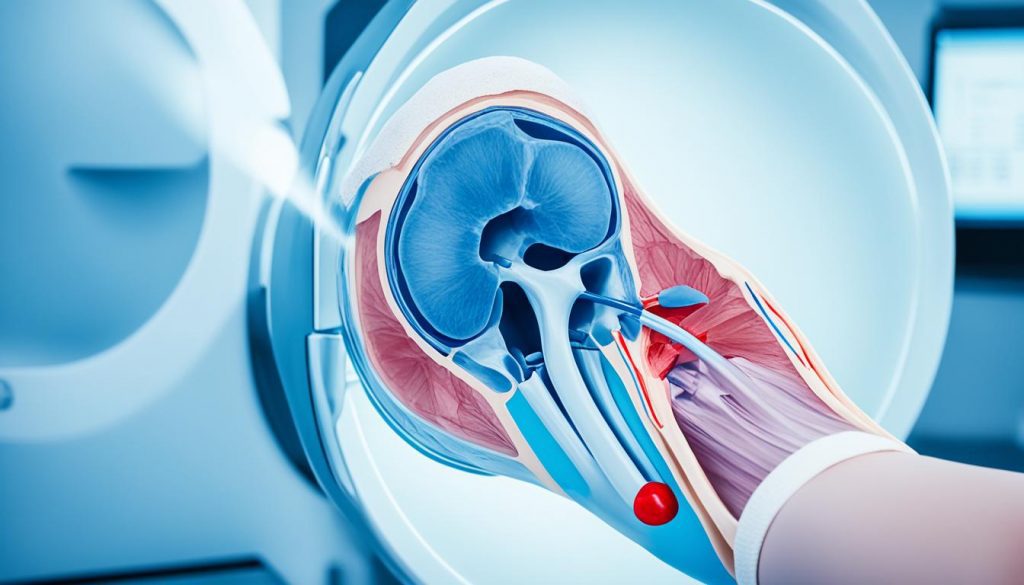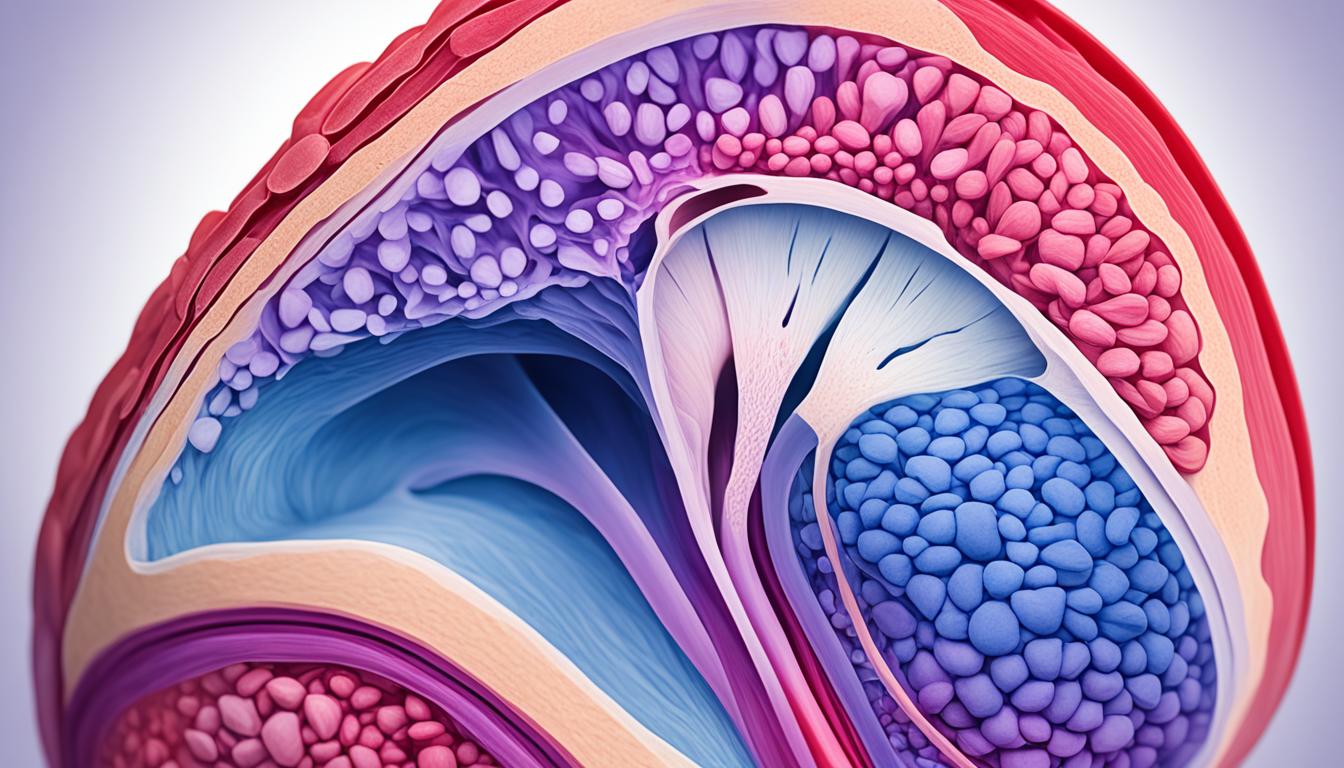A Baker’s cyst, also known as a popliteal cyst, is a lump of fluid behind the knee. This benign swelling is from the knee joint’s semimembranosus or other synovial bursa. A tear in the knee’s meniscal cartilage often causes a Baker’s cyst. Knee arthritis, rheumatoid arthritis, and other knee conditions can also lead to its formation.
People with a Baker’s cyst usually experience swelling, stiffness, and pain behind their knee. Diagnosing this cyst requires a physical exam, where the doctor compares both knees. Imaging tests like MRI might also be needed. Treatment might include resting, taking medication, draining the fluid, or, rarely, surgery.
Key Takeaways:
- Baker’s cyst, also known as a popliteal cyst, is a fluid-filled swelling behind the knee
- Causes can include knee arthritis, meniscal tear, and other knee problems
- Diagnosis involves a physical exam and possibly imaging tests
- Treatment options include rest, medication, fluid drainage, and surgery in rare cases
- Stem cell therapy is an innovative treatment option for Baker’s cyst
What is Baker’s Cyst?
A Baker’s cyst is a fluid-filled lump that forms behind the knee. It’s also known as a popliteal cyst or synovial cyst. The cyst comes about from too much synovial fluid. This fluid helps lubricate the knee joint.
The extra fluid collects in a sac in the back of the knee. This causes the swelling known as a Baker’s cyst. People often notice swelling, tightness, and pain behind their knee. Although anyone can get a Baker’s cyst, they are more common in women and those over 40. The cyst’s size varies and might not always hurt. However, if the cyst bursts, it can cause sharp pain and redness in the calf.
Often, Baker’s cysts link to knee issues like a meniscal tear or arthritis. They form when the knee makes more synovial fluid to help with these conditions. Knowing about Baker’s cysts is key in finding the right treatment. This helps ease pain, decrease swelling, and better knee function.
Causes of Baker’s Cyst
A Baker’s cyst, or a popliteal cyst, forms when there’s too much synovial fluid. This fluid helps to lubricate your knee joint.
Too much synovial fluid can collect behind the knee. When this happens, it creates a cyst.
Several health issues can lead to a Baker’s cyst. These issues include:
- Rheumatoid arthritis: This long-term disease makes the lining of the joints swell, leading to more fluid.
- Osteoarthritis: This wear-and-tear disease breaks down joint cartilage, causing pain and swelling.
- Gout: This arthritis form happens when uric acid crystals build up in the joints, causing inflammation.
Injuries or swelling in the knee joint can also lead to a Baker’s cyst.
Conditions like osteoarthritis, rheumatoid arthritis, and gout link to joint issues. These issues can make more synovial fluid. So, they raise the chance of getting a Baker’s cyst.
It’s important to know what health problems can cause a Baker’s cyst. Knowing this can help find the best way to treat the cyst and tackle its root cause.
Diagnosis of Baker’s Cyst
The process of diagnosing a Baker’s cyst starts with a thorough check-up by a healthcare provider. The doctor examines the knee, focusing on the back area. They look for a soft bump or swelling, typical of a Baker’s cyst. They’ll compare the affected knee with the healthy one to spot differences. The doctor also checks how well the knee moves. This is because movement problems can hint at a cyst or other knee issues. They’ll watch for signs of a meniscal tear, like the knee locking or catching.
To make sure of the diagnosis and rule out other issues, imaging tests are often used. Doctors usually perform MRI and ultrasound scans. These scans show detailed pictures of the knee, helping the doctor see the cyst’s size and position. MRI is great for spotting Baker’s cysts because it can also find other knee problems, like tears in the meniscus. X-rays help find different knee issues but can’t show the cyst or tear directly.
Illustrative Example:

Treatment for Baker’s Cyst
Sometimes, Baker’s cyst might go away without needing any treatment. But if the cyst grows large and causes a lot of pain or discomfort, there are several treatments available.
- Medication: To reduce pain and swelling, doctors can inject medications like corticosteroids into the knee. This relief is usually only temporary but can help lessen the symptoms caused by the cyst.
- Fluid drainage: Removing the extra fluid can sometimes be necessary. A procedure known as aspiration uses a needle and ultrasound to pull out this fluid. After draining it, doctors might inject steroids to cut down the inflammation.
- Physical therapy: Playing an important role, physical therapy includes exercises and methods to make the knee muscles stronger. This helps in making the knee more stable and moving better, which can improve symptoms and stop new cysts from forming.
- Surgery: Surgery might be needed when other treatments don’t work. It aims to fix the problem that caused the cyst, like a tear in the knee cartilage. The surgeon might remove the cyst and fix any knee issues. Surgery is usually for those whose cysts keep hurting or get in the way of daily life.
Choosing the right treatment depends on talking to a doctor who knows about your situation and how severe the Baker’s cyst is.
The goal of treating Baker’s cyst is to make you feel better, bring down the swelling, and solve whatever caused the cyst. With the right care and handling, people with Baker’s cyst can get better and have a healthier knee.
| Treatment Option | Description |
|---|---|
| Medication | Injection of corticosteroids to reduce pain and inflammation. |
| Fluid drainage | Aspiration of excess fluid from the cyst using a needle guided by ultrasound, followed by steroid injections to further reduce inflammation. |
| Physical therapy | Exercises and techniques to strengthen the muscles around the knee, improving stability and range of motion. |
| Surgery | Removal of the cyst and addressing any underlying knee abnormalities or causes. |
Stem Cell Therapy for Baker’s Cyst
Stem cell therapy is a new way to treat Baker’s cyst. It uses the body’s stem cells to heal and renew. These cells can change into different types, helping repair tissues.
Two main stem cell treatments are used for Baker’s cyst:
1. Micro-fragmented Fat Injections:
This method takes fat cells from your body. The cells are turned into a powerful healing solution. Then, it’s injected to ease pain and swelling. This approach has helped many feel better from Baker’s cyst troubles.
2. Bone Marrow Aspirate Concentrate (BMAC) Injections:
BMAC injections use special stem cells from the bone marrow. A tiny bit of marrow is taken and made into a stem cell solution. This solution is then injected, helping mend damaged cells and tissue. BMAC has been successful in healing and reducing swelling.
Both treatments are not too invasive. They’ve been effective in reducing pain and helping knees work better for those with Baker’s cyst. But remember, it’s key to talk with a doctor to choose the right treatment for you.
| Treatment | Benefits |
|---|---|
| Micro-fragmented Fat Injections | – Utilizes adipose cells for pain and inflammation relief – Minimally invasive – Promotes tissue regeneration |
| Bone Marrow Aspirate Concentrate (BMAC) Injections | – Utilizes mesenchymal stem cells for tissue regeneration – Effective in reducing inflammation – Minimally invasive procedure |
Conclusion
A Baker’s cyst is a fluid-filled swelling behind the knee. It’s also known as a popliteal cyst. While small cysts might go away on their own, big ones need medical care.
There are several ways to treat a Baker’s cyst. These include resting, taking medicine for pain and swelling, and getting physical therapy. In some cases, doctors might need to remove the fluid or even do surgery.
But there’s a new way to treat it with stem cell therapy. This method uses your own cells to help heal and lessen swelling. Treatments like micro-fragmented fat and bone marrow injections are showing good results.
If you think you have a Baker’s cyst, see a healthcare provider. They’ll check you out and suggest the best treatment. This may include the new stem cell therapy for the best outcome.

